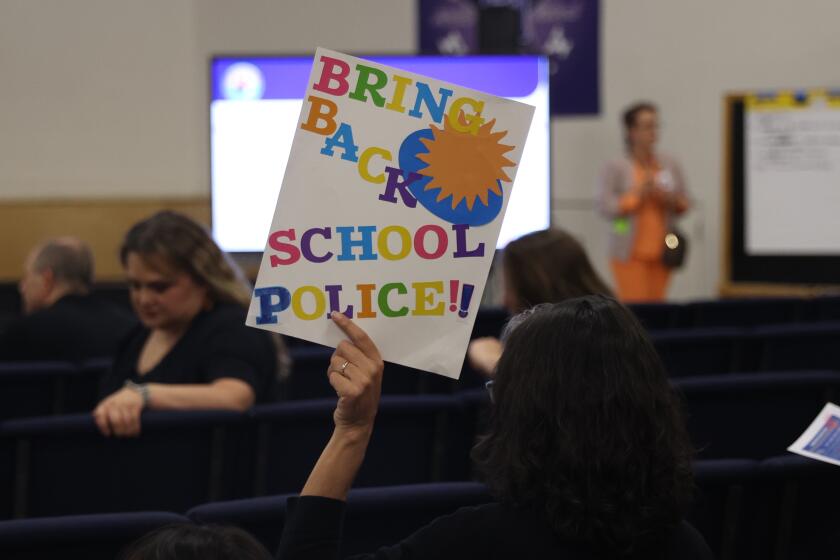President Says Bond Issue’s Defeat Might Not Close CSSM : Education: But rejection of measure could limit Cal State San Marcos’ enrollment to junior, seniors and graduate students.
Cal State San Marcos might not close because of the state’s budget crunch--but could be crippled to the point of dysfunction as a university campus if voters reject a separate $900 million bond issue in June, university officials said Wednesday.
That characterization comes on the heels of a remark on Tuesday by California State University Chancellor Barry Munitz that the campus was “in jeopardy” of being closed because of expected budget cutbacks.
His comment to reporters in Sacramento brought alarm to North County, with students calling the campus in fear of their future, and administrators trying to decipher the weight of Munitz’s initial remarks.
Max Benavidez, spokesman for the California State University system, said he wasn’t willing to speculate on Wednesday whether Cal State San Marcos’ future rests on the fate of Sacramento’s budget deliberations.
But that aside, he said, the 2-year-old university, the state’s 20th and newest campus, would be frozen in an incomplete state if voters on June 2 don’t approve Proposition 153, which seeks $900 million for higher education across the state.
“If the bond issue isn’t passed, the campus will be put at risk and will be stalled where it’s at for some time, which is not a good thing for us,” he said.
Cal State San Marcos President Bill Stacy said Wednesday that, without the $27 million his campus would receive from Proposition 153 proceeds, the four primary buildings scheduled to open this fall on the permanent campus would be mere shells without furnishings and equipment.
Preparations would be stalled indefinitely for five new buildings that the university wants open by the fall of 1995, to accommodate the enrollment of the university’s first freshman class.
About 1,300 juniors, seniors and graduate students are enrolled now at Cal State San Marcos and attending classes in a San Marcos business park. Enrollment is expected to double when the fall, 1992, semester begins.
Stacy said the funds to furnish and equip the campus buildings were expected to come from a $900-million bond issue in 1990. But that issue was divided into two separate $450-million issues, and, even though the first one was approved in June, 1990, its partner proposition, which would have funded equipment and furnishings at Cal State San Marcos, was rejected by voters.
So now, “even though our science lab building is near completion, we don’t have a single bit of equipment or furnishings in it,” Stacy said.
“We’ve got a disaster if we can’t get the science equipment and furnishings in place. We wouldn’t be able to teach biology or chemistry or math or computer science to the students we expect this fall,” he said.
Science students now are shepherded to a different classroom complex in San Marcos that can accommodate only 12 science students at a time, he said.
If Proposition 153 fails, “a student would have every right to ask the university, ‘Where are you going to put me? Where’s the chemistry lab?’ And the answer is, I have room for you--but only 12 at a time--and if there are going to be 200 of you majoring in science, then this is unacceptable,” Stacy said.
So, while the university probably won’t literally be shut down because of the state budget crisis, many students might find Cal State San Marcos unable to meet its needs if Proposition 153 is rejected, Stacy said. From their perspective, it would not be a functioning university.
“It would make it so bloomin’ hard for us to produce the kind of learning environment students are entitled to, it would be hard to imagine how we could proceed,” Stacy said.
The president said he expected he could find, from other campuses or other sources, such rudimentary furnishings as desks and chairs to fill his buildings. But he said he doesn’t know of any source--whether a business or private philanthropist--who could provide the money or equipment to stock the science and computer rooms.
The four buildings now nearing completion on the campus--one containing lecture halls and classrooms, another for science, a commons building with conference facilities and the Craven Hall faculty and administration building with its computer labs and temporary library--are sufficient to accommodate 3,500 students, the projected enrollment through spring of 1995.
The following semester, the university hopes to open its doors to its first underclassmen, bringing 1,000 more students on campus.
And, by then, the university wants to have five more buildings completed: a permanent library, a performing arts center, a physical education complex and two instructional buildings.
“If Proposition 153 doesn’t pass, it becomes an issue of whether we’ll be able to take freshmen because we won’t have the facilities to handle that growth,” Stacy said.
In Long Beach, CSU spokesman Benavidez said he wouldn’t say whether it was conceivable that Cal State San Marcos could be shut down because of the state’s budget crisis, characterizing the question put to him as “hypothetical.”
He repeated Munitz’s position that, “if we have to cut our budget 10% to 15%, we’ll have to consider closing campuses.”
Softening Munitz’s remarks on Tuesday, Benavidez said, “That doesn’t mean the campus that needs closing would be San Marcos.”
More to Read
Start your day right
Sign up for Essential California for news, features and recommendations from the L.A. Times and beyond in your inbox six days a week.
You may occasionally receive promotional content from the Los Angeles Times.






